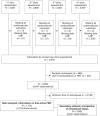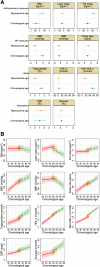Cardiovascular health in the menopause transition: a longitudinal study of up to 3892 women with up to four repeated measures of risk factors
- PMID: 35974322
- PMCID: PMC9382827
- DOI: 10.1186/s12916-022-02454-6
Cardiovascular health in the menopause transition: a longitudinal study of up to 3892 women with up to four repeated measures of risk factors
Abstract
Background: Women experience adverse changes in cardiovascular health in mid-life; whether the menopausal transition influences these remains strongly debated. The aim of this study was to examine associations of reproductive age (time since final menstrual period (FMP)) with change in carotid intima media thickness (CIMT) and cardiovascular risk factors and determine the role of chronological and reproductive age.
Methods: We used data from 1702 women from a pregnancy-based UK cohort who had up to four repeat cardiovascular health measures between mean age 51 (SD = 4.0) and 56 (SD = 3.6) years and experienced a natural menopause. Multilevel models were used to assess the relationship between cardiovascular measures and time since FMP (reproductive age), whilst adjusting for the underlying effects of chronological age and confounders (socioeconomic factors, body mass index, smoking, alcohol, parity, age at menarche). In addition, we looked at the relationship between cardiovascular measures by chronological age according to menopausal stages (pre-menopause, peri-menopause and post-menopause) using information from women who had and had not experienced menopause (N = 3892).
Results: There was no strong evidence that reproductive age was associated with CIMT (difference in mean 0.8 μm/year, 95% CI - 0.4, 2.1), whereas there was a strong positive association of chronological age (7.6 μm/year, 95% CI 6.3, 8.9). Consistent with this, we found weaker linear associations of reproductive compared with chronological age for atherosclerotic risk factors, such as with systolic blood pressure (- 0.1 mmHg/year, 95% CI - 0.3, 0.1, and 0.4 mmHg/year, 95% CI 0.2, 0.5, respectively) and non-HDL-cholesterol (0.02 mmol/l/year, 95% CI 0.005, 0.03, and 0.06, 95% CI 0.04, 0.07, respectively). In contrast, associations with fat mass (0.06 kg/m2/year, 95% CI 0.03, 0.10, and 0 kg/m2/year, 95% CI - 0.04, 0.04, respectively) and C-reactive protein (0.01, 95% CI 0.001, 0.02, and 0.01, 95% CI - 0.001, 0.02 natural logged mg/l/year, respectively) were stronger for reproductive compared with chronological age. Both reproductive and chronological age were (weakly) positively associated with glucose (0.002, 95% CI 0.0001, 0.003, and 0.002, 95% CI 0.0001, 0.003 natural logged mmol/l/year, respectively).
Conclusions: Our results suggest that going through the menopausal transition does not further increase women's risk of atherosclerosis (measured by CIMT) beyond effects of ageing. Menopausal transition may, in additional to ageing, modestly increase adiposity and glucose levels and therefore a possible associated diabetes risk.
Keywords: ALSPAC; CIMT; Cardiovascular; Menopausal transition; Menopause; Reproductive age; Time to final menstrual period.
© 2022. The Author(s).
Conflict of interest statement
AF and KT report funding from UK Medical Research Council, for work unrelated to that presented here. DAL reports receiving support from several national and international government and charity research funders, and grants from Medtronic Ltd for work unrelated to that presented here. SMN has received speaker’s fees and participated in medical advisory boards for Roche. GLC, ALGS, FK, PIW, and NS declare that they have no competing interests.
Figures



Similar articles
-
Abdominal visceral adipose tissue over the menopause transition and carotid atherosclerosis: the SWAN heart study.Menopause. 2021 Mar 1;28(6):626-633. doi: 10.1097/GME.0000000000001755. Menopause. 2021. PMID: 33651741 Free PMC article.
-
Changes in women's physical function in mid-life by reproductive age and hormones: a longitudinal study.BMC Womens Health. 2022 Nov 24;22(1):473. doi: 10.1186/s12905-022-02070-9. BMC Womens Health. 2022. PMID: 36434722 Free PMC article.
-
Age at Menopause in Relationship to Lipid Changes and Subclinical Carotid Disease Across 20 Years: Study of Women's Health Across the Nation.J Am Heart Assoc. 2021 Sep 21;10(18):e021362. doi: 10.1161/JAHA.121.021362. Epub 2021 Sep 6. J Am Heart Assoc. 2021. PMID: 34482713 Free PMC article.
-
The menopausal transition period and cardiovascular risk.Nat Rev Cardiol. 2024 Mar;21(3):203-211. doi: 10.1038/s41569-023-00926-7. Epub 2023 Sep 26. Nat Rev Cardiol. 2024. PMID: 37752349 Review.
-
Women's Reproductive Milestones and Cardiovascular Disease Risk: A Review of Reports and Opportunities From the CARDIA Study.J Am Heart Assoc. 2023 Mar 7;12(5):e028132. doi: 10.1161/JAHA.122.028132. Epub 2023 Feb 27. J Am Heart Assoc. 2023. PMID: 36847077 Free PMC article. Review.
Cited by
-
Substantial Lipid Increases During Menopausal Transition in Korean Middle-Aged Women.J Korean Med Sci. 2023 Aug 7;38(31):e238. doi: 10.3346/jkms.2023.38.e238. J Korean Med Sci. 2023. PMID: 37550806 Free PMC article.
-
The influence of 17β-estradiol plus norethisterone acetate treatment on markers of glucose and insulin metabolism in women: a systematic review and meta-analysis of randomized controlled trials.Front Endocrinol (Lausanne). 2023 May 17;14:1137406. doi: 10.3389/fendo.2023.1137406. eCollection 2023. Front Endocrinol (Lausanne). 2023. PMID: 37265701 Free PMC article.
-
Women, lipids, and atherosclerotic cardiovascular disease: a call to action from the European Atherosclerosis Society.Eur Heart J. 2023 Oct 14;44(39):4157-4173. doi: 10.1093/eurheartj/ehad472. Eur Heart J. 2023. PMID: 37611089 Free PMC article.
-
The impact of reproductive factors on the metabolic profile of females from menarche to menopause.Nat Commun. 2024 Feb 6;15(1):1103. doi: 10.1038/s41467-023-44459-6. Nat Commun. 2024. PMID: 38320991 Free PMC article.
References
Publication types
MeSH terms
Substances
Grants and funding
LinkOut - more resources
Full Text Sources
Medical
Research Materials

